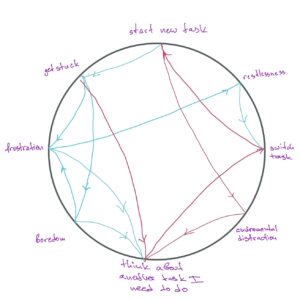The Problem
I sometimes find myself getting stuck in a loop of mindlessly switching from task to task without meaningfully engaging with a single thing.
When attempting to be productive, I will spend some amount of time on one task, get bored/frustrated/impatient and decide to focus on something else. I might start working on a PSET, spend 10 minutes on it, get frustrated and decide to try working on a CS assignment. Because I cannot escape my feelings, I’d get frustrated with the CS assignment and begin working on another PSET and so on. In the process I’d accomplish very little, feel heaps of frustration and waste a lot of time.
The Plan
I find myself stuck in a mindless task switching loop more often when I’m tired and/or stressed. Given that I tend to be less stressed at the beginning of the quarter, I focused my tracking on the evenings when I’m most tired.
Initially I set reminders for every 30 minutes between 6-9pm. After two prompts I realized that 30 minutes is too big of an interval and I do not remember all the tasks I worked on so I switched to getting prompted every 15 minutes.
Additionally, I tried to note and write down any notable emotions that I felt in that time period so that I can find any correlations between feelings and mindless task switching.
When reminded, I’d wrote down everything I have spent my time on in the past 15 minutes and any motions that might have come up during that time.
Since I mindlessly switch tasks mostly when working, I explicitly dedicated these 3 evening hours to school work.
The Results
Even though the 15 minute prompts were the appropriate time intervals to capture the frequency of mindless task switching,
I have to acknowledge their impact on my workflow. I expected their effect to be minimal and slightly disruptive but I was surprised to experience their positive effects. When lost in a mindless task or mindless task switching, getting prompted brought awareness and forced me to reflect on my actions, the ongoing task and state of mind. This forced awareness was helpful in getting me to refocus on the task on hand.
At other times the prompts were interrupted my workflow and forced me to switch tasks. I’d have to abandon my work to write down the information required by this assignment. Regaining my focus in these situations was difficult. Sometimes it took me 15 minutes to get back on task only to be prompted again.
Driving factors to task switching

I identified the following factors involved in my disruptive habit.
1. Boredom
I failed to realize how significant the feeling of boredom is to mindless task switching. When facing a task that failed to capture my interest, I observed that I’d just shift my attention elsewhere. The novelty of a different task (or task I have abandoned not that long ago) was enough to drive this behavior.
2. Feeling of restlessness
Restlessness emerged as another driving factor to task switching. Having the urge to physically and/or mentally move on triggered a desire of change of task.
3.Frustration
Frustration also played a significant role in triggering and perpetuating mindless task switching loops. Frustration emerged more often as a secondary emotion in response to feeling bored, restless or stuck but nevertheless it was a powerful
4. Getting stuck
Encountering a difficulty in my homework or not knowing how to start or proceed with a task triggered a desire to move on to something new.
3. Environmental distractions
Not surprisingly distractions from my environment affected my behavior. As noted earlier, the tracking prompts themselves affected my behavior in both good and bad ways. But even without them, I live in a world full of distractions: there are messages and emails that demand my attention
I have noticed that it is easier to overcome the mental factors that drive my habit when I am well rested and less stressed. Fatigue and anxiety wear down my executive functioning and makes it so much more difficult to stay on task. It is easier to work though feeling frustrated, stuck or disengaged when well rested but at the end of the day, these tasks become that much more difficult.
Fish-bone diagram

For my second model I decided to do a fish bone diagram. I think that it brings some simplicity and clarity to my habit ecosystem that might be difficult to extract from the connected circle.
What would I have done differently
I realized that it is very challenging to record my actions in sufficient detail while minimizing the effects of the tracking prompts on my behavior. If I’m to do this experiment again I’d probably go for a slightly longer prompting intervals (20 minutes) or I might experiment with some less disruptive methods of recording such as voice memos.
This assignment has been illuminating in noticing the factors that play a role in mindless task switching. I was also pleasantly surprised to discover that periodic prompts can be helpful in getting me unstuck and bringing awareness to my actions.



